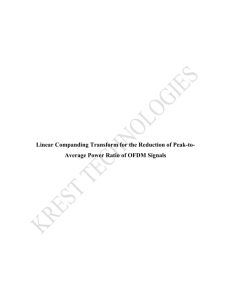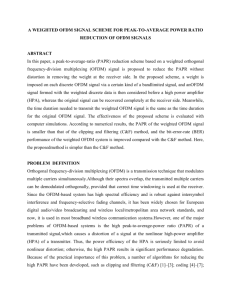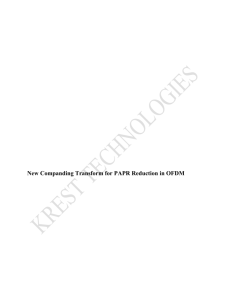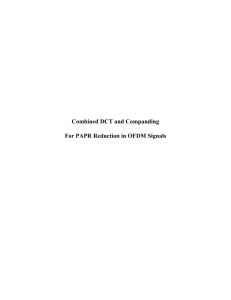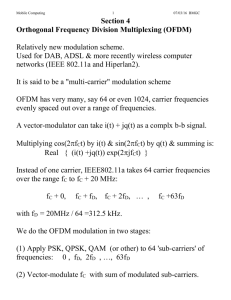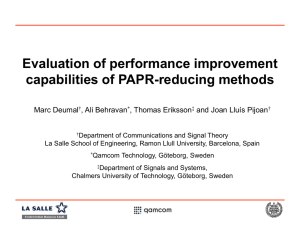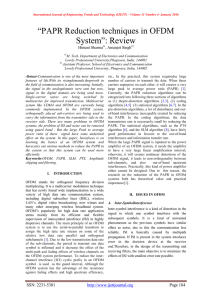A Humble Method Based On Trimming PAPR in OFDM Systems
advertisement
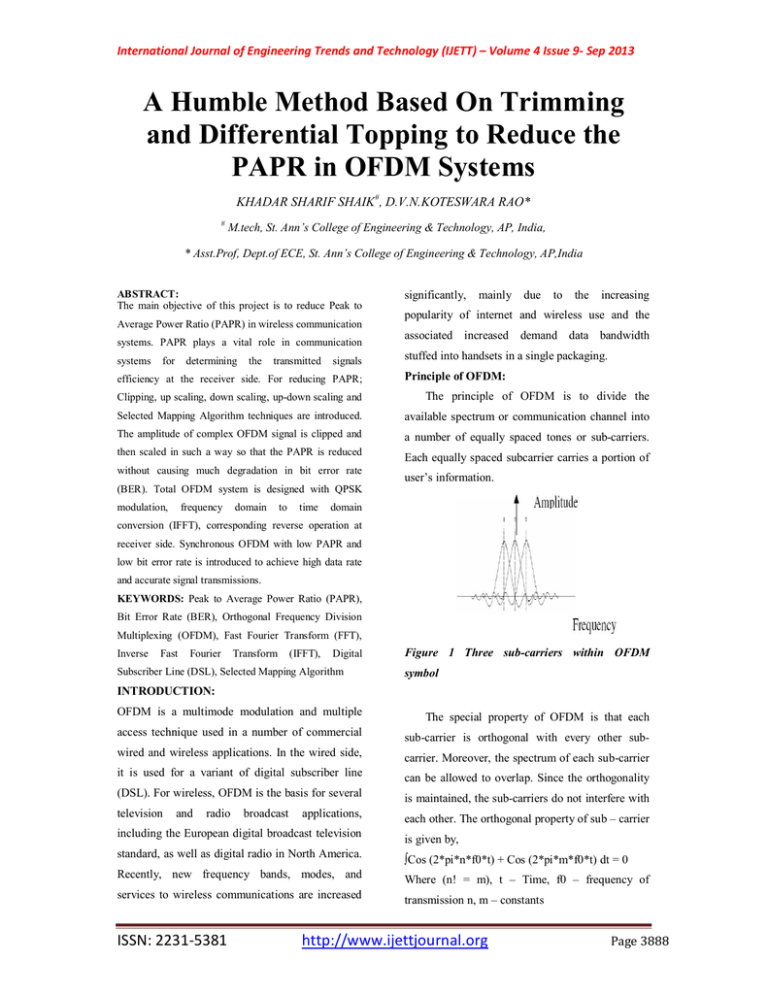
International Journal of Engineering Trends and Technology (IJETT) – Volume 4 Issue 9- Sep 2013 A Humble Method Based On Trimming and Differential Topping to Reduce the PAPR in OFDM Systems KHADAR SHARIF SHAIK# , D.V.N.KOTESWARA RAO* # M.tech, St. Ann’s College of Engineering & Technology, AP, India, * Asst.Prof, Dept.of ECE, St. Ann’s College of Engineering & Technology, AP,India ABSTRACT: The main objective of this project is to reduce Peak to Average Power Ratio (PAPR) in wireless communication systems. PAPR plays a vital role in communication systems for determining the transmitted signals efficiency at the receiver side. For reducing PAPR; significantly, mainly due to the increasing popularity of internet and wireless use and the associated increased demand data bandwidth stuffed into handsets in a single packaging. Principle of OFDM: Clipping, up scaling, down scaling, up-down scaling and The principle of OFDM is to divide the Selected Mapping Algorithm techniques are introduced. available spectrum or communication channel into The amplitude of complex OFDM signal is clipped and a number of equally spaced tones or sub-carriers. then scaled in such a way so that the PAPR is reduced Each equally spaced subcarrier carries a portion of without causing much degradation in bit error rate user’s information. (BER). Total OFDM system is designed with QPSK modulation, frequency domain to time domain conversion (IFFT), corresponding reverse operation at receiver side. Synchronous OFDM with low PAPR and low bit error rate is introduced to achieve high data rate and accurate signal transmissions. KEYWORDS: Peak to Average Power Ratio (PAPR), Bit Error Rate (BER), Orthogonal Frequency Division Multiplexing (OFDM), Fast Fourier Transform (FFT), Inverse Fast Fourier Transform (IFFT), Digital Subscriber Line (DSL), Selected Mapping Algorithm Figure 1 Three sub-carriers within OFDM symbol INTRODUCTION: OFDM is a multimode modulation and multiple The special property of OFDM is that each access technique used in a number of commercial sub-carrier is orthogonal with every other sub- wired and wireless applications. In the wired side, carrier. Moreover, the spectrum of each sub-carrier it is used for a variant of digital subscriber line can be allowed to overlap. Since the orthogonality (DSL). For wireless, OFDM is the basis for several is maintained, the sub-carriers do not interfere with television each other. The orthogonal property of sub – carrier and radio broadcast applications, including the European digital broadcast television is given by, standard, as well as digital radio in North America. ∫Cos (2*pi*n*f0*t) + Cos (2*pi*m*f0*t) dt = 0 Recently, new frequency bands, modes, and Where (n! = m), t – Time, f0 – frequency of services to wireless communications are increased transmission n, m – constants ISSN: 2231-5381 http://www.ijettjournal.org Page 3888 International Journal of Engineering Trends and Technology (IJETT) – Volume 4 Issue 9- Sep 2013 Figure 1 shows the OFDM spectrum with three sub-carrier from interfering with another called sub-carriers. The orthogonality can be completely Inter Carrier Interference (ICI). maintained, even though the signal passes through DESIGNING OF OFDM SYSTEM: a time dispersive channel, by introducing a cyclic QPSK MODULATION: path. A cyclic prefix is a copy of the last part of the OFDM symbol which is pretended to the QPSK (Quadrature Phase Shift Keying) is type transmitted symbol. This makes the transmitted of phase shift keying. Unlike BPSK which is a signal periodic so that it avoids Inter Symbol DSBCS Interference (ISI) and Inter Carrier Interference information for the message, QPSK is also a (ICI). DSBCS modulation scheme but it sends two bits of Benefits of OFDM: digital information a time (without the use of modulation scheme with digital OFDM enables the creation of a very flexible another carrier frequency).The amount of radio system architecture, which can be used efficiently frequency spectrum required to transmit QPSK for a wide range of services, including both voice reliably is half that required for BPSK signals, and data. OFDM segments the available spectrum which in turn makes room for more users on the according to frequency rather than TDMA which channel. At the input of the modulator, the digital segments the available spectrum according to time data’s even bits (i.e., bits 0,2,4 and so on) are and CDMA according to spreading codes. OFDM stripped from the data stream by a “bit-splitter” and can also be considered as multiple access technique are multiplied with a carrier to generate a BPSK such that individual carriers can be assigned to signal (called PSKI). At the same time, the data’s different users. OFDM can be combined with odd bits (i.e., bits 1,3,5 and so on) are stripped from frequency hopping to create a spread spectrum the data stream and are multiplied with the same system, realizing the benefits of frequency diversity carrier to generate a second BPSK signal (called and interference averaging of CDMA technique. PSKQ). However, the PSKQ signal’s carrier is phase The cyclic prefix called as a guard time makes the shifted by 90o before being modulated.. channel to behave as the transmitted waveforms were from time minus infinite which prevents one QAM/PSK Mapping IFFT s/p P/S and PAPR Reduction D/A and HPA OFDM processing for transmitter and receiver, FFT and IFFT respectively. Note that the IFFT operation can be As shown in Figs 4 and 8, the IFFT and FFT are the most time consuming part of the base-band performed using the FFT operation depicted in Fig. 9. By swapping the real and imaginary parts of the input sequence and swapping the real and ISSN: 2231-5381 http://www.ijettjournal.org Page 3889 International Journal of Engineering Trends and Technology (IJETT) – Volume 4 Issue 9- Sep 2013 imaginary parts of the output sequence, the FFT fast enough. Due to the simplicity, the radix-2, function is employed for the IFFT computation. decimation-in-time FFT algorithm is chosen, Hence, if the OFDM transceiver is operated in time implemented, and used for both IFFT and FFT division multiplexing (TDM) mode, there is no operation additional hardware or software required for using respectively. The “butterfly” is the smallest the OFDM transmitter and receiver separately. In computational unit and implemented by assembly other words, one DSP should be able to handle code. at the transmitter and receiver, both IFFT and FFT operations if its throughput is QAM/PSK Demapping P/S FFT S/P and Inverse PAPR Reduction Algorithm A/D Scale Up: In this method, we scale up the lower h(x) = αxp, if x > αxp amplitudes of the signal by a factor of β. This leads = γx, if B ≤ x ≤ αxp to increase the average value without affecting the = x, if x < B (9) peak values. Therefore, the resulting PAPR where xp is the amplitude peak value occurring in reduces. The PAPR reduction function can be an OFDM symbol block, α is the factor deciding defined as the clipping threshold in terms of percentage of the h(x) = αxp, if x > αxp peak value and γ is the scaling factor for the range = βx, if x < A [β,αxp] whose value is less than one. = x, if A ≤ x ≤ αxp Scale Up and Down: In this method, we combine where xp is the amplitude peak value occurring in an OFDM symbol block, α is the factor deciding the clipping threshold in terms of percentage of the peak value and β is the scaling factor for the range [0,A) whose value is greater than s. The values of the parameters used are mentioned at the end of this section. both the above-mentioned approaches i.e. upscaling and down-scaling. This method exploits the advantages of both the methods. Hence, a PAPR can be reduced considerably. The PAPR reduction function can be defined as h(x) = αxp, if x > αxp = γx, if B ≤ x ≤ αxp Scale Down: In this method, we scale down the = βx, if x < A higher amplitudes of the signal by a factor of γ. = x, if A ≤ x ≤ B (10) This leads to decrease the peak value. Although the where xp is the amplitude peak value occurring in average value would also fall down, the resulting an OFDM symbol block, α is the factor deciding PAPR reduces. Because the reduction in peak the clipping threshold power is greater than the reduction in the average in terms of percentage of the peak value. β is the power. The PAPR reduction function can be scaling facto for the range [0,A) and γ is the scaling defined as factor for the range [B,αxp]. ISSN: 2231-5381 http://www.ijettjournal.org Page 3890 International Journal of Engineering Trends and Technology (IJETT) – Volume 4 Issue 9- Sep 2013 In the SLM technique[5] the transmitter generates channel except that the demodulator output is left a set of sufficiently different candidate data blocks, unquantized. Such a model is called a Discrete- all representing the Input Continuous-Output original data same information as the block, and selects the channel. Indeed, the most discrete-time input symbols X take their values in favourable for transmission. A block of the SLM a finite alphabet while channel output symbols Y technique is shown in Fig. 1. Each data block is can multiplied by U different phase sequences, each channel is characterized of length N, B(u) = [bu,0 = 1, 2, …, U, resulting in probability density function relating the real U modified data blocks. To include the unmodified output value to all possible inputs. data block in the set of modified data blocks, we set RESULTS: take any values along the real line. Such a by the conditional B(1) as the all-one vector of length N. Let us denote the modified data block for the u th phase sequence X(u) = [X0bu,0 T XN–1bu ] , u = 1, 2, …, U. After applying SLM to X, the ,N– 1multicarrier signal becomes , bu,1 , …, bu,N–1 T], u , X1bu,1, …, X(u)(t)=1/n(∑Xn bu,n.ej2pift) Among the modified data blocks X(u), u = 1, 2, …, U, the one with the lowest PAPR is selected for transmission. Information about the selected phase sequence should be transmitted to the receiver as side information. At the receiver the reverse operation is performed to recover the original data block. The SLM technique implementation needs U IDFT operations, and the number of required side information bits is log2U for each data block. This approach is applicable for all types of modulation with any number of subcarriers. The amount of PAPR reduction for SLM depends on the number of phase sequences U and the design of the phase sequences. AWGN channel characteristics: Additive white Gaussian noise (AWGN) is a channel model in which the only impairment to communication is a linear addition of wideband or white noise with a constant spectral density (expressed as watts per hertz of bandwidth) and a Gaussian distribution of amplitude. In this channel model, an additive noise is included with modulator and demodulator as parts of the ISSN: 2231-5381 http://www.ijettjournal.org Page 3891 International Journal of Engineering Trends and Technology (IJETT) – Volume 4 Issue 9- Sep 2013 wireless personal area network (PAN) ultrawideband (UWB) IEEE 802.15.3a implementation suggested by WiMedia Alliance. The OFDM based multiple access technology OFDMA is also used in several 4G and pre-4G cellular networks and mobile broadband standards CONCLUSION: Finally, This project established an efficient and huge tremendous channel accessing communication in OFDM with less PAPR and reduced Bit Error Rate Probability. Using simulations, we obtained the values of threshold for clipping and parameters for scaling with a view to reduce PAPR without degradation in BER. We Comparison Table: have presented the PAPR and BER performance for all the techniques considered. The proposed updown scaling technique is able to achieve PAPR reduction of the order of 8.5 dB from 12 dB PAPR initially REFERENCES: [ 1 ]H. Taub, D. L. Schilling, G. Saha, “Taub’s Principles of ADVANTAGES: Using adequate channel Communication” : Tata McGraw Hill, 2009. coding and interleaving one can recover symbols lost due to the frequency selectivity of the [2 ] T. S. \ Rappaport, “ Wireless Communication: Principles and Practice ” : 2 Nd Edition, Prentice Hall, 2011 [3] S. H. Han, J. H. Lee, “An Overview of Peak – to – Average Power Ratio Reduction Techniques for Multicarrier channel. Transmission” Channel equalization becomes simpler Communication, April 2007. than by using adaptive equalization [4] S. H. Han, J. H. Lee, “PAPR Reduction of OFDM Signals , IEEE Transaction on Wireless Using a Reduced Complexity PTS Technique”, IEEE Signal techniques with single carrier systems. Processing Letters, Vol. 11, No. 11, November 2010. OFDM is computationally efficient by [5] Wang X. B., Tjhung T. T., Ng C. S., “Red uction of peak-to- using FFT techniques to implement the average power ratio of modulation and demodulation functions. OFDM system using a companding techni que”, IEEE Transaction on Broadcasting, vol. 45, No. 3, pp. 303–307, Sept. 1999. [6] Jiang T., Yang Y., Song Y., “Exponential comp anding APPLICATIONS: transform for PAPR reduction in OFDM systems”, IEEE Transaction on Br oadcasting, vol. 51, No. 2, pp. 244–248, June The wireless LAN (WLAN) radio interfaces IEEE 2005. 802.11a, g, n and HIPERLAN/2. The digital radio [7] Huang J. L., Zheng J., Leta ief K. B., Gu J., “Companding systems DAB/EUREKA 147, DAB+, Digital Radio Transform for Reduction in Peak-to-Average Power Ratio of OFDM Signals”, IEEE Transaction on Wireless Mondiale, HD Radio, T-DMB and ISDB-TSB. The ISSN: 2231-5381 http://www.ijettjournal.org Page 3892 International Journal of Engineering Trends and Technology (IJETT) – Volume 4 Issue 9- Sep 2013 Communications, Vol. 03, No. 6, pp. 2030-2039, November [9] Hou, J., Ge J. H., Li J., “Trapezoidal companding scheme for 2004. peak-to-average power [8] Sulaiman A. A., Ehab F. B., Mohamed Darwish A. E., Electro nics Letters, Vol. No. pp 1349 – 1351, Dec. 2009. ratio reduction of OFDM signals,” “Linear Companding Transform for the Reduction of Peak-toAverage Power Ratio of OFDM Signals”, IEEE Transaction Broadcasting, Vol. 55, No. 1, pp. 195-200, March 2009. ISSN: 2231-5381 http://www.ijettjournal.org Page 3893


